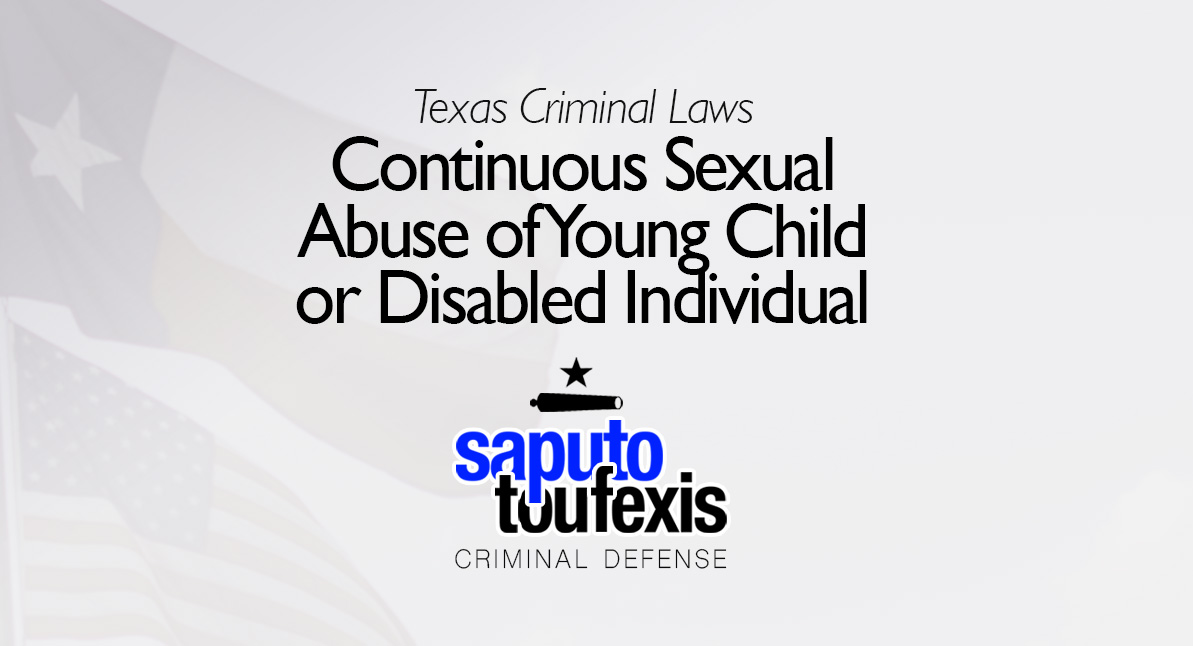The Texas Continuous Sexual Abuse law applies to cases where the prosecutors claim that a victim was younger than 14 years of age or “disabled.”
FAQs about the
Continuous Sexual Abuse law in Texas
- What is the current Texas law about Continuous Sexual Abuse of Young Child or Disabled Individual?
- What is “sexual abuse“?
- Who can be charged with Continuous Sexual Abuse?
- Who qualifies as a “child” under the law?
- What are the possible defenses available to an accused person?
- How long will I have to register as a sex offender if I am convicted of this offense?
- Who is considered a “disabled person” under the law?
- What is the statute of limitation for Continuous Sexual Abuse in Texas?
- What is the penalty for a Texas Continuous Sexual Abuse offense?
- Can you get probation for Continuous Sexual Abuse in Texas?
- Do I have to register as a sex offender in Texas if guilty of Continuous Sexual Abuse?
- What level of crime is Continuous Sexual Abuse in Texas?
In order for the law to apply, you must be at least 17 years old at the time of the offense. Also, the prosecutors must allege that you engaged in two or more sexual acts over a 30-day time period or longer. Because the offense requires a pattern of sexual abuse, it carries a higher punishment then any of the single sex crimes on which it is based.
Have you been charged with Continuous Sexual Abuse of Young Child or Disabled Individual? Contact us today to discuss legal representation.
or Text or Call (888) 239-9305
A charge of Continuous Sexual Abuse of a Child Under 14 ranks as one of the most severe offenses one can face, second only to Capital Murder. Pause and consider the gravity of that statement. Aside from capital murder, which may result in the death penalty, this is the harshest criminal charge in Texas.
This is a relatively new offense in the Texas Penal Code. The offense, originally called Continuous Sexual Abuse of Young Child or Children and now called Continuous Sexual Abuse of Young Child or Disabled Individual, was created as part of a set of laws called “Jessica’s Law,” in 2007 by the Texas Legislature. At the time, the Texas legislature was examining Texas criminal sex offenses in response to a nationwide call for tougher sex offender laws throughout the United States. Prior to 2007, there was no law that specifically punished a pattern of engaging in multiple child sex offenses.
The Texas legislature codified this criminal offense in Texas Penal Code Section 21.02. The law was not amended in 2023. However, the law was most recently amended in 2021 by expanding this law to include disabled individuals (in addition to children).
The Penal Code classifies the Texas Continuous Sexual Abuse law under Title 5 “Offenses Against the Person,” Chapter 21 “Sexual Offenses.” Learn more about the Texas offense of Continuous Sexual Abuse of Young Child or Disabled Individual below.
What is the current Texas law about Continuous Sexual Abuse of Young Child or Disabled Individual?
Texas law currently defines the offense of Continuous Sexual Abuse of Young Child or Disabled Individual in Penal Code Section §21.02 as follows:[1]
(b) A person commits an offense if:
(1) during a period that is 30 or more days in duration, the person commits two or more acts of sexual abuse, regardless of whether the acts of sexual abuse are committed against one or more victims; and
(2) at the time of the commission of each of the acts of sexual abuse, the actor is 17 years of age or older and the victim is:
(A) a child younger than 14 years of age, regardless of whether the actor knows the age of the victim at the time of the offense; or
(B) a disabled individual.
Amendments effective in 2021
The legislature expanded the applicability of the Continuous Sexual Abuse law to disabled individuals in 2021 and amended the name of the statute to reflect this.[2]
Amendments effective in 2017
Subsection (b)(2) was amended in 2017 to clarify that it does not matter whether you know the age of the accuser at the time of the offense.[3] So, even if they gave you a validly-issued government driver’s license, looked like they were 30, you met them at a bar and have a spouse, you can still be convicted of this offense.
Other important points about the law
The jury does not have to agree unanimously on the specific acts of sexual abuse or the exact dates on which the abuse occurred.[4] The jurors only have to agree unanimously that two or more acts of sexual abuse were committed by the defendant during a period that is 30 or more days in duration. The state’s attorney does not need to prove that all sexual abuse acts were committed against the same victim.[5]
For example, a person has committed Continuous Sexual Abuse of a Young Child by committing Indecency with a Child against Jane Doe (age 8) on March 2, 2008 and by committing sexual assault against John Doe (age 13) on May 2, 2008. However, if a person commits sexual assault against Jane Doe on March 1 and commits sexual assault against John Doe on March 29, the element of “within a 30 day period” has not been met. The person may still be convicted of two separate instances of Sexual Assault.
What is “sexual abuse“?
As described above, Continuous Sexual Abuse of Young Child or Disabled Individual offense requires multiple acts of “acts of sexual abuse.” A person who has committed one of the following offenses has committed an act of sexual abuse for purposes of committing this offense:[6]
- Aggravated Kidnapping with the intent to violate or abuse the victim sexually (PC §20.04(a)(4))
- Indecency with a Child (by contact with genitals or anus but not breast) (PC §21.11(a)(1))
- Sexual Assault (PC §22.011)
- Aggravated Sexual Assault (PC §22.021)
- Burglary of a Habitation with the intent to violate or abuse the victim sexually (§30.02(d))
- Sexual Performance by a Child (PC §43.05)
- Trafficking of Persons (PC §20A.02(a)(3),(4),(7) or (8))
- Compelling Prostitution (PC §43.05(a)(2))
However, the prosecuting attorneys are not supposed to charge a person with one of the offenses listed above and Continuous Sexual Abuse of a Young Child for the same victim unless (1) the person is charged in the alternative, (2) the offense occurred during less than a thirty day time period, or (3) it is found to be a lesser-included offense.[7] A person who has committed multiple counts of sexual assault against a single child victim is only supposed to be charged with a single count of Continuous Sexual Abuse of a Young Child.[8]
Who can be charged with Continuous Sexual Abuse?
The alleged victim(s) must be younger than 14 years of age at the time the assault occurred, and the accused person must be at least 17 years old.[9] For example, if John Doe (17 years old) commits sexual assault against Jane Doe (13 years old) on March 1, 2015 and again on April 1, 2015, John Doe has committed Continuous Sexual Abuse of a Young Child. However, if John Doe (17 years old) commits sexual assault against Jane Doe (15 years old) on the same two dates, John Doe has not committed Continuous Sexual Abuse of a Young Child, although he could still be prosecuted by the state’s attorneys under other sex crimes laws. Additionally, a 17 year old in this circumstance may have an affirmative defense, as described in more detail below.
Who qualifies as a “child” under the law?
The statute defines child as a person younger than 17 years old.[10] However, the statute also limits its applicability to prosecutions of child abuse offenses where the alleged victims are 13 years old or younger.[11] Therefore, a person has not committed this particular offense if the victim is 14 years old or older.
What are the possible defenses available to an accused person?
Everyone is entitled to a jury trial, and the most common defense is to fight the state’s attempt to prove you “guilty beyond a reasonable doubt.”
However, there is an affirmative defense available called the “Romeo and Juliet” defense. This defense would protect two younger people who are close in age, such as a 17-year-old senior in high school and a 13-year-old freshman in high school. This defense only applies if “the actor is not more than five years older than the victim, the actor did not use duress, force, or a threat, and the actor is not a registered sex offender.”[12]
How long will I have to register as a sex offender if I am convicted of this offense?
If you are convicted of Continuous Sexual Abuse of a Young Child or Disabled Individual Texas law requires you to register for life unless special circumstances apply.[13] Note that this determination can, technically, be more complicated. But practically speaking, these convictions will require lifetime registration.
Who is considered a “disabled person” under the law?
The law defines “disabled individual” as “a person older than 13 years of age who by reason of age or physical or mental disease, defect, or injury is substantially unable to protect the person’s self from harm or to provide food, shelter, or medical care for the person’s self.”[14]
There are no limitations on who prosecutors and police can deem are “disabled.” Accordingly, whether someone meets this definition is ultimately up to a jury. One prosecutor might argue that people who are depressed are substantially unable to protect themselves from harm, while another prosecutor might argue that someone who has chronic obesity is disabled because they can’t provide food for themselves without the assitance of family. Prosecutors can simply state that a person is disabled and argue their case to a jury.
What is the statute of limitation for Continuous Sexual Abuse in Texas?
Continuous Sexual Abuse has no limitations period under Texas law.[15]
What is the penalty for a Texas Continuous Sexual Abuse offense?
This offense is punished as a first-degree felony, punishable by 5-99 years in prison, or life, and a maximum fine of $10,000.[16] However, Continuous Sexual Abuse of a Young Child carries a special minimum punishment of 25 years. Persons convicted of Continuous Sexual Abuse of a Young Child are not eligible for parole.[17]
Can you get probation for Continuous Sexual Abuse in Texas?
There does not appear to be a limitation on a judge’s or jury’s ability to recommend probation for Continuous Sexual Abuse cases.[18]
Note, however, that no matter the offense, neither judges nor juries may recommend community supervision for any suspended sentence over 10 years, so any mandatory minimum case will not be eligible for probation.[19] Also, the Texas code prohibits judges from accepting deferred adjudication pleas on these cases.[20]
Do I have to register as a sex offender in Texas if guilty of Continuous Sexual Abuse?
Any Texas Continuous Sexual Abuse conviction or adjudication, including deferred adjudication, requires registration as a sex offender.[21]
What level of crime is Continuous Sexual Abuse in Texas?
The Penal Code classifies the punishment for Continuous Sexual Abuse as either a first degree felony, with a minimum 25 year prison sentence.
Learn more about the penalty range for this offense in the section above.
Legal References:
^1. Texas Penal Code §21.02. This law is current as of 2024.^2. HB 375, 87th Texas Legislature (RS), Sections 1.01 and 1.02^3. Texas Penal Code §21.02(b)(2), as amended by HB 1808, 85th Texas Legislature (RS), Section 2. As amended:
(2) at the time of the commission of each of the acts of sexual abuse, the actor is 17 years of age or older and the victim is a child younger than 14 years of age, regardless of whether the actor knows the age of the victim at the time of the offense.
^4. Texas Penal Code §21.02(d)^5. Texas Penal Code §21.02(b)(1)^6. Texas Penal Code §21.02(c)^7. Texas Penal Code §21.02(e)^8. Texas Penal Code §21.02(f)^9. Texas Penal Code §21.02(b)(2)^10. Texas Penal Code §21.02(a), referencing the definition of “child” under 22.011(c):
(c) In this section: (1) “Child” means a person younger than 17 years of age.
^11. Schunior v. Texas^12 Texas Penal Code §21.02(g)^13. Texas Code of Criminal Procedure §62.101(a)(1) requires lifetime registration for all “sexually violent offenses,” a term that is described at § 62.001(6)(A) to include Continuous Sexual Abuse of a Young Child. §62.101(a)(1) has three big exceptions that apply to all lifetime registration requirements: “Except as provided by Subsection (b) and Subchapter I” and for an “adjudication of delinquent conduct.” Subsection (b) refers to discretionary transfers to criminal court from juvenile court proceedings, and Subchapter I refers to early termination procedures. Because you have to be 17 years old at the time of offense to be convicted of Continuous Sexual Abuse of a Young Child, these cases won’t be in juvenile court (see Texas Family Code §51.02(2)), and there won’t be an adjudication of delinquent conduct for the same reason. It is, however, technically possible for you to be eligible for early termination, but it is a relatively narrow situation.^14. Texas Penal Code §21.02(a)(2), cross referencing Texas Penal Code §22.02(b)(3)^15. Code of Criminal Procedure 12.01(1)(D)^16. Texas Penal Code §21.02(h) and Texas Penal Code §12.32^17. Texas Government Code §508.145(a)^18. See Art. 42A.056, Texas Code of Criminal Procedure and Art. 42A.054, Texas Code of Criminal Procedure^19. Art. 42A.053(c), Texas Code of Criminal Procedure^20. Art. 42A.102(b)(3)(A), Texas Code of Criminal Procedure^21. Code of Criminal Procedure, Article 62.001(5)(A)










